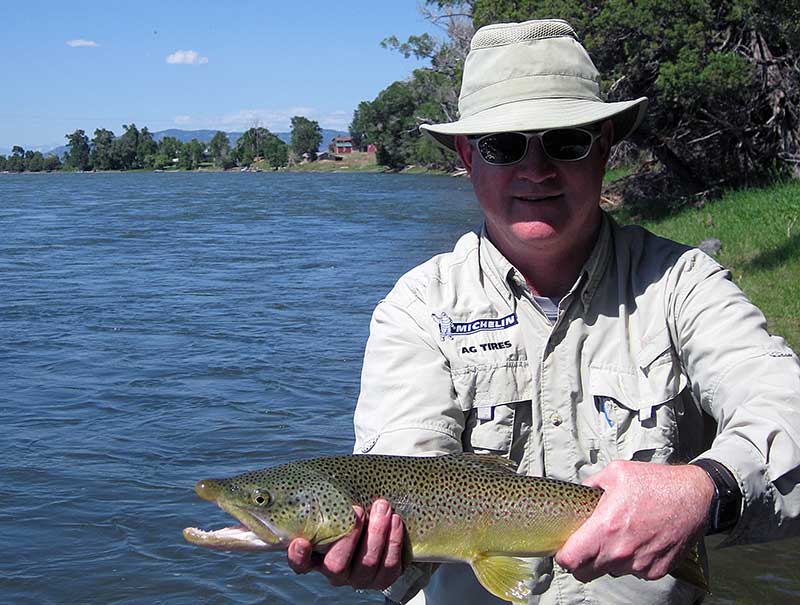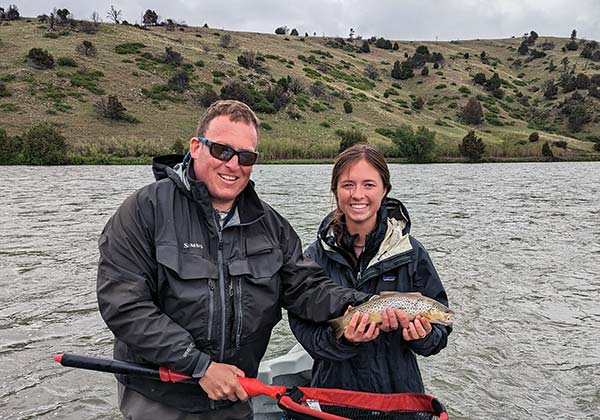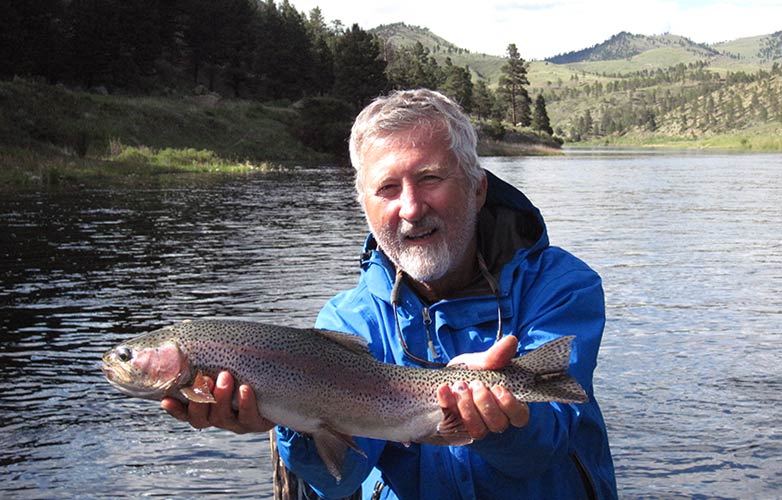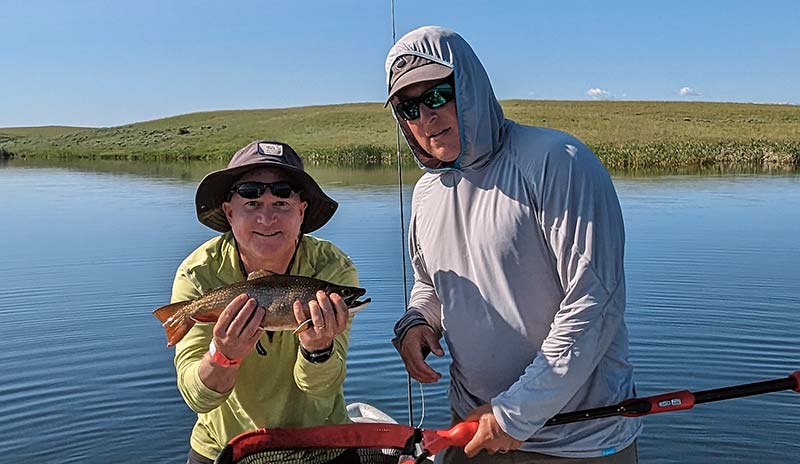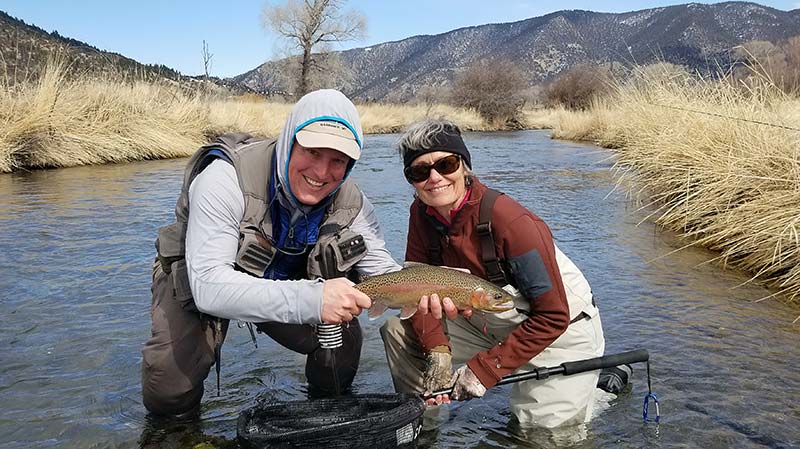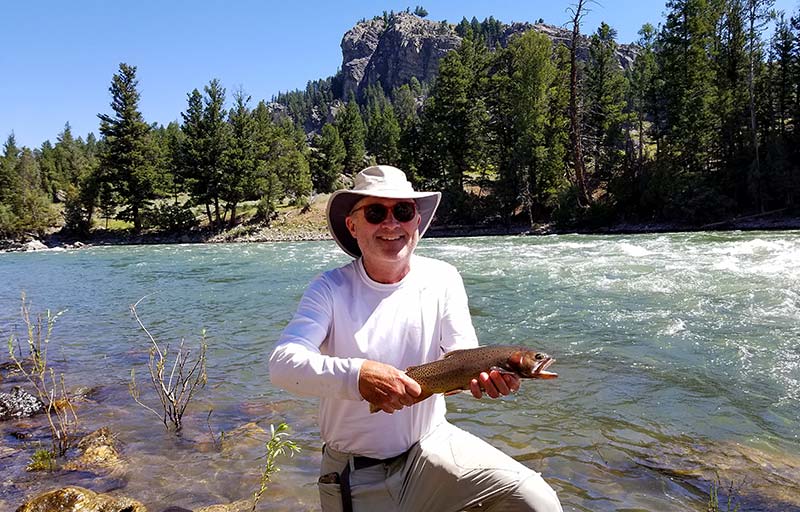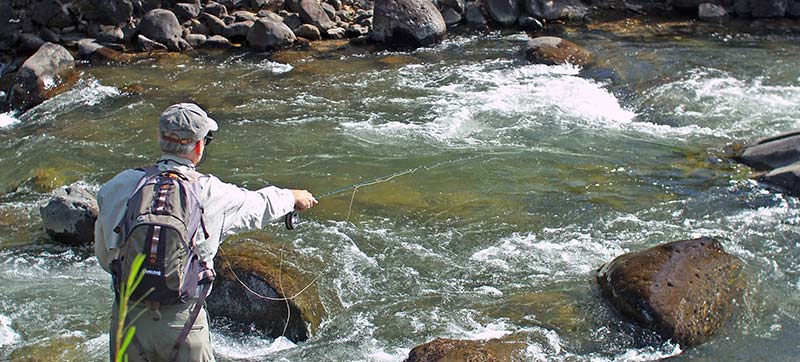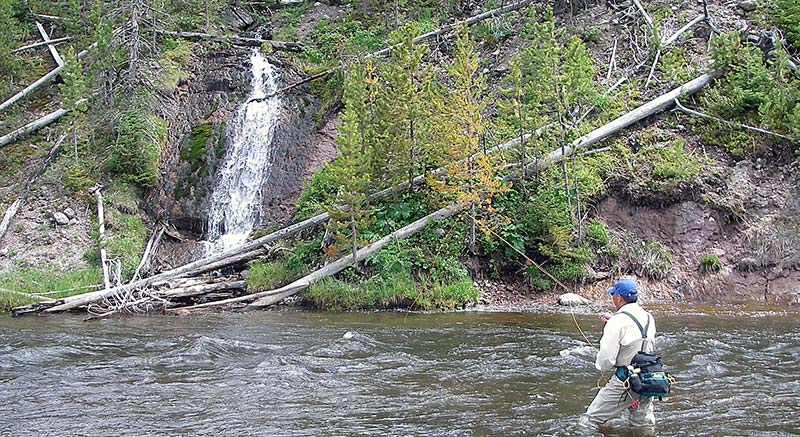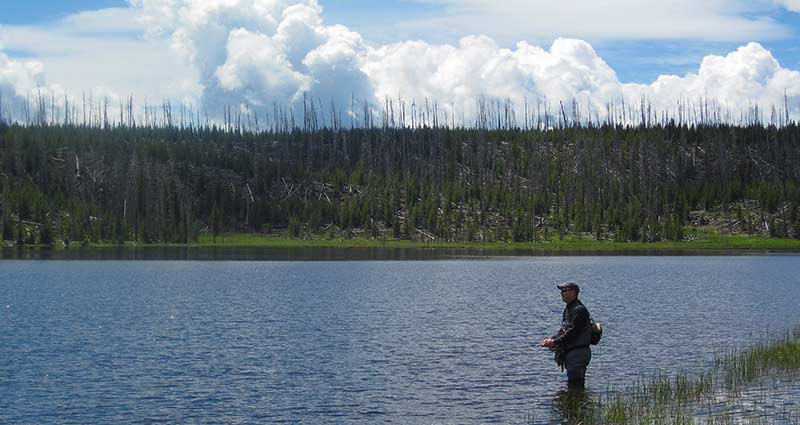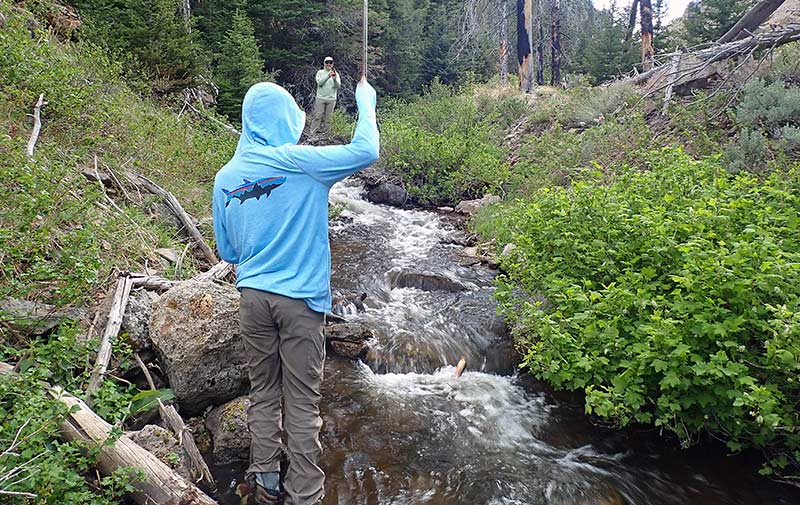From tiny mountain creeks we jump across on wade trips to raging rivers we float in whitewater rafts, here's where we guide
Our guides fish all over Montana (in particular we have a soft spot for chasing pike), but we focus our guide services on our home waters near Livingston. This page covers the area rivers, streams, and lakes on which we guide: when and how we fish them, the sorts of clients who tend to like these places, etc. Use the information here to familiarize yourself with our guided trip destinations and think about where you might like to fish, conditions permitting.
Note that we cannot guarantee a given fishery will be available at any specific time. Summer storms, low or warm water, the spring snowmelt, and simply the waters that are fishing well are the final judges of where we’ll fish. That said, if a particular destination sounds perfect for you, by all means tell us when you’re booking.
The information on this page overlaps quite a bit with the information in the Our Fisheries section of the site. Those pages include general fishing information about our waters, whereas this page focuses on guided fishing. Our Fishing Report might also be of interest.
There’s no place like home, and the Yellowstone River is home, both in Montana and in Yellowstone Park (discussed separately below). Livingston sits right on the ‘Stone’s banks, within about an hour of all of its prime trout water. We run more than half our float trips on this river, and know it like the backs of our hands. Walter has run more Yankee Jim Canyon guided float trips than any other guide or outfitter, for example.
Most of our trips on the Yellowstone are float trips. We use rafts in the rough sections and when we’re launching at difficult accesses (sliding the boats through the bushes) and drift boats elsewhere. The Yellowstone also offers good opportunities for float & wade trips, especially in spring and fall, and we also run a few wade trips per season, especially in the winter.
A secret to the Yellowstone’s appeal is the fact that it changes character every twenty to forty miles. Wild and rowdy Yankee Jim Canyon feels like a different river than the gentle “Bird Float” 25 miles downstream. If you’re up for anything, it’s possible to float the Yellowstone fifteen or twenty days in a row and not see the same section twice, and on many of those days you won’t even use the same flies and tactics or catch the same species of fish.
Because it is so varied, the Yellowstone is suitable for all anglers, ranging from beginners looking to catch their first fish on fly tackle to experts who want that one special brown trout. We can put together trips on the Yellowstone for people looking for a mellow day on a pretty stretch of river as well as those who want whitewater thrills along with lots of trout.
We tend to float up high on the river near Gardiner when we’re looking for cutthroat trout and hoping to fish dry flies (“dry or die” clients love this stretch, including Yankee Jim Canyon), then move downstream with beginners as well as advanced anglers interested in targeting larger fish versus numbers. The precise floats we run depend on the time of year, streamflow, and wind speed and direction.
Ice-permitting, the Yellowstone can be productive all year except during the spring melt. The melt runs from sometime in the first three weeks of May (generally around May 10) until sometime in the latter half of June or first few days of July and turns the river into an unfishable chocolate stew. If you have your heart set on fishing the Yellowstone, it’s best to plan to come in April or from July onward, rather than in May and June.

Pardon the pun, but the Boulder River rocks. This Yellowstone River tributary is fast and furious, choked with boulders and downed trees, and packed with aggressive midsize rainbow and brown trout. There aren’t many truly large fish, but when the Boulder is really on, it seems like a 12-incher sits behind every rock, and there are lots of rocks.
While there are some walk and wade opportunities on the Boulder in early spring and late summer through fall, from a guide’s perspective this is basically a float and float-wade river. We access the Boulder with our fishing rafts, and often jump out to wade-fish good areas and to take a break from the fast-paced floating this raucous river otherwise demands.
The float season on the Boulder is short: there are windows from late April through late June when the river is both high enough to float and not choked with snowmelt, but the prime season is three to four weeks from late June into late July as the spring melt recedes for good. After that, the river gets too low to float in full-size rafts, though we’re hoping to add a micro-raft to our fleet this season to help us stretch the season, especially with clients who don’t mind helping drag the boat over shallow spots.
Adventurous intermediate to expert clients love the Boulder. Beginners, anyone with poor mobility, and those who want a slow-paced, mellow day on the river absolutely should not fish here. It’s too fast and rough, and it can be dangerous both to float and to wade. For much of the short float season, clients should expect to wear life jackets while we’re underway, due to the remote but real chance of falling out of the boat or having your guide hang the raft on a rock and flip it.
When we have the right clients, the Boulder fishes great with big dry-dropper rigs. As befits the river’s name, the Boulder is chock-full of stoneflies, so we usually have clients fish a dry stonefly with a stonefly nymph dropper unless insect hatches demand otherwise. Good caddis and PMD hatches tend to break up the stonefly show in mid-July.
While it sees a tenth the pressure the Yellowstone does, the Boulder is also about a tenth the size. For this reason we usually like to start early to get out in front of the competition. We’ll often meet at 6:00AM just to accomplish this. Once we hit the river, there are two or three good put-ins and take-outs, so it’s possible to fish the Boulder for two full days without more than a few miles of repetition.

No river in Montana is more famous than the Madison, and no river gets fished harder. While we don’t like guiding among lots of competition, the Madison has a key advantage over some other float rivers: it is protected by two dams and a natural lake, so the spring snowmelt almost never makes the river too muddy to fish.
Our guides focus on the Madison in May and June when other rivers nearby are either always or usually muddy. The Madison is also a sneaker bet for us in September, when its crowds start to taper off.
Livingston is a long way from the more-famous upper stretches of the river between Quake Lake and Ennis, more than two hours, so we usually stick to the Lower Madison west of Bozeman, about an hour away. This stretch of river is shallow, wide, and weedy. It’s primarily holds rainbow and brown trout, but there’s also a rapidly-expanding native westslope cutthroat population thanks to a recent successful reintroduction in a major tributary creek.
While the Lower Madison’s fish can be moody and both fishing and recreational traffic are high, the best guided fly fishing tactics are pretty easy for beginners to pick up, so the Lower Madison is a great option for rookies who would rather float than wade. Regardless of client skill, we tend to fish nymphs and crayfish here, looking for lanes between weedbeds and sudden drop-offs. Most fishing is done from the drift boat, but when the water is low and the fish start eating dry flies, we’ll often run shorter stretches and run float & wade trips instead.
As noted, the Upper Madison is a long way from here, but it’s available as a secondary option, especially in June and July when it’s at its best. While it’s likewise mostly wide and shallow, this stretch of the Madison can fish very well with dry flies in late June and July, especially during and just after its famous Salmonfly hatch. We like the stretch from Lyons Bridge to Ruby best, since this stretch tends to have the best dry fly bite.

The Stillwater River is the Boulder’s neighbor to the east. It’s not quite as steep, fast, or rough as the Boulder, while still remaining faster and choppier than the Yellowstone. It’s also quite a bit larger than the Boulder, which means it remains high enough to float (and float-wade) with fly fishing whitewater rafts until at least September. This makes it a great choice for anglers who don’t want quite so frenetic a float as the Boulder provides, as well as clients who do want a fast, choppy alternative to the Yellowstone who happen to be here when the Boulder is too low. What’s not to love?
The drive, for one. The Stillwater enters the Yellowstone about 90 miles east of Livingston, and some of the best floats begin more than 20 miles upstream from the confluence, including several miles on slow-driving gravel roads. A bigger factor is the historic 2022 flood. While upper and middle stretches of the Stillwater held up to this catastrophic flood, lower reaches got pretty thrashed.
Before the flood, the lower Stillwater was fast becoming our favorite float trip option in August and September, when the dry fly fishing can be phenomenal. We still love it, but it’s not as good as it used to be. Will it come back? Of course! It’ll just take a few seasons.

The Missouri River tailwater downstream from Holter Dam is one of the West’s most famous and most-fished stretches of river. The “MO” is the best river in the region during the spring runoff cycle, so when most other rivers are dirty, we join the crowds for a few days each May.
This area is roughly 3hr from Livingston, so it’s too far to go on a day trip. Instead we base out of Wolf Creek, Montana, and fish for a couple days at a time before heading home. In general these trips are best for repeat clients.
Most of the fishing on this stretch of the “MO” in the spring is nymphing with scuds, sowbugs, San Juan Worms, and Blue-winged Olive nymphs. If water levels are reasonable (the water can get quite high even when clear), some dry fly fishing is possible throughout May, though it gets much better late in the month.
Near the headwaters 60–90 minutes from Livingston, the Missouri is a totally different river. Here it’s a broad, slow, prairie river. There are some bruiser trout here, but this is a far better fishery for a completely different and much larger gamefish: carp. When we guide here—less than we’d like—we’re almost always chasing carp, and the occasional monster rainbow or brown trout, walleye, or pike is a bonus.
This carp fishing is only suitable for advanced clients who want to get away from crowds during the hot, low water periods from late July through early September. The carp stay active no matter how warm the water gets, and bright sun aids in spotting these fish. Almost all our fishing for these hefty (4–12lb) fish is sight-fishing. We’ll often use the boat as transportation, spotting pods of feeding carp in the shallows, then pulling over to sneak up on them from below.
Despite the reputation of carp as a “trash” fish, this is not easy fishing. Carp are as spooky as many saltwater fish, much spookier than almost all trout. When they do eat, the first run is almost always into your backing, so breaking off or losing the fish on a rock or log is just as likely as landing one. As such, we suggest holding off on a carp trip until we believe your skills are a match.

Farm ponds in the Midwest and East grow big bass. Ranch ponds in Montana grow big trout. It’s just that simple. We guide on eight private ranch lakes on four properties. These lakes are among our favorite options in May, June, and October, when they’re at their most productive and some of our other options can be shaky.
We mostly use subsurface flies on lake trips: leeches, San Juan Worms, and assorted nymphs. That said, some lakes offer inconsistent put potentially fantastic dry fly opportunities during Callibaetis and damselfly hatches, particularly in June. When the trout are up in the shallows, even the nymph and leech fishing can involve a lot of exciting sight-fishing.
While they seldom produce lots of fish, our private lake guided trips produce big ones. The average trout runs 14 to 20 inches, and we’ve had clients land pigs over 8lbs. Most of these fish are rainbow trout stocked as fingerlings, but many lakes hold other species. Real highlights are the huge wild brook trout found in a few lakes. Most small-stream brookies around here are hand-size. In the private lakes they average 15 inches. The best time for the brook trout as well as the potential for lots of trout is in early October.
We always bring the drift boat to private lakes. When guiding solo anglers we’ll even attach an electric trolling motor. On larger lakes we do most or all of the fishing from the boat, while on small lakes we’ll often do half or more of the fishing while stalking the banks.
The only downsides of private lakes are additional access fees payable to the landowner ($80–$120 per angler per day in 2024), casting distances that can be difficult for beginners and younger anglers, and the ever-present danger of extreme winds, which almost always put the fish off. If you’re an angler who isn’t daunted by these factors, we strongly suggest a private lake trip.

The world-famous Paradise Valley spring creeks—Nelson’s, Armstrong’s, and Depuy’s—flow about ten minutes south of Livingston. These glass-clear, weedy creeks get fished hard year-round by skilled anglers, so their solid (but seldom huge) rainbow and brown trout are fussy and almost always difficult to catch. The appeal is fooling a few really challenging fish. That’s also the lack of appeal: these are terrible beginner fisheries.
While absolute peak season on the creeks is during the late June and July Pale Morning Dun hatches, we tend to focus on the creeks in the spring. March and April bring good Blue-winged Olive hatches, plus large runs of spawning rainbow trout from the Yellowstone. We never target active spawners (it is unethical to do so), but the spawning activity stirs up bugs and eggs which both the resident trout and migrants gobble in deeper water downstream of spawning areas.
For expert clients, the spring creeks have two major downsides (besides the overall challenge of the fishing, which some experts see as a plus): additional access fees and very limited availability. Access fees range from $45 per angler per day in the offseason to $120 angler/day during the PMD season peak in June and July. Despite the high pricing, PMD season on the creeks is routinely fully-booked a year in advance, which calls for extreme early planning to be sure of getting a slot. This is one case where Yellowstone Country Fly Fishing’s small size is a problem rather than an asset; the big outfitters block book most of the fishing during this period, leaving small fry like us out in the cold.
Because of the additional expenses involved and the extreme difficulty of the trout that call them home, we never guide beginners on the spring creeks. It is simply too unlikely that beginners will pick up the sport quickly enough to have any success whatsoever. When the fishing is hard, as it can be even during the best times, even experts can struggle. Anyone who likes the idea of such difficult fishing should definitely consider a spring creek day, especially in the spring.

Low-elevation reservoirs near Livingston offer a variety of opportunities for anglers with a bit of fly fishing experience who want to try something different from the usual river float trips. For trout, they’re great bets in the spring and early summer, especially during the spring melt. For carp anglers, they can produce great hopper fishing for 10lb bruisers in late summer, when almost no one fishes these reservoirs. As one of the few Montana outfitters with the power boat necessary to fish these lakes, we’d love to introduce you to them.
We fish on around half a dozen reservoirs within about 90 minutes of Livingston, each of which offers something a bit different to the angler: from shots at walleye in nearby Dailey Lake to dry fly sipping “gulpers” in Ennis Lake. All lakes hold trout (of various species) at a solid average size, often 14–18 inches, and most hold other game fish as well. Most of the fishing is subsurface, with leeches and various nymphs, but some dry fly fishing is possible in late spring and early summer for trout and in late summer for carp. While we do most of our fishing from the power boat, often drifting with the wind, shore fishing can also be very good, especially in April when the trout can be in inches of water right after ice-out.
One of the key advantages of public reservoirs is very limited fly fishing pressure. While local bait and lure anglers hit the reservoirs hard, especially on weekends, fly anglers are a rare sight. This means the trout in these reservoirs can actually be pretty dumb at times. The major problem is the potential for wind: even power boats can get blown off all but the smallest reservoirs when the wind and waves get going. For this reason, we tend to fish these reservoirs early in the day before the breezes start blowing.
Because our power boat is small (a 16ft tiller-steer jon boat with a 40hp gas motor and an electric trolling motor), we suggest these destinations for solo anglers more than pairs, though we can handle two clients as long as they don’t mind tight quarters in the boat. These trips are not for beginners using fly tackle, though beginners can do well using spinning tackle.

The Yellowstone River bisects Yellowstone Park from north to south. While there’s good fishing from the remote headwaters all the way to the park’s north boundary at Gardiner, we concentrate our efforts on the Grand and Black Canyons of the Yellowstone in the north-central part of the park, basically from Tower Falls down to Gardiner.
These stretches are by far our favorite walk & wade destinations during the July through September peak season. These canyons hit the sweet spot between hiking distance (generally 2–4 miles one-way) and difficulty, numbers of fish, and size of fish to enable us to shed crowds and catch good numbers of solid and sometimes large native cutthroat trout, as well as a few rainbows and browns in downstream reaches.
Trout in these stretches of the Yellowstone tend to be fat and very healthy. Depending on the stretch and the year, they tend to average somewhere between 8 and 16 inches. The average size is larger when there are fewer fish, smaller when there are more fish. 18-inch trout are worth a photo but not uncommon, and I have had a handful of lucky clients catch fish approaching 24 inches. Regardless of fish size, this is prime water for streamer and dry fly or dry-dropper fishing. About the only time clients who hike into these waters should expect to fish nymphs under indicators is immediately following the spring melt, which ends sometime in June.
The Grand Canyon of the Yellowstone is one of the few large rivers that’s often fishable most of June. When it is, the fishing is phenomenal. We are talking real potential for 50-fish days for skilled anglers. I once had a client count 106 trout on the day, including four “doubles” in which he caught trout on both his flies at once. The core season in both canyons is July through September, with ten to twenty trout a much more realistic and not at all uncommon goal for skilled anglers.
Regardless of season, streamers are probably our bread and butter flies on this water, with large Woolly Buggers usually our favorite options. Dry fly fishing centers on large stonefly dries and hoppers through most of the summer, shading over to various mayfly-imitating dries in fall. These fall hatches can be wonderful on September afternoons, though the fishing is overall a bit less consistent than earlier in the season.
While this water is best for intermediate to expert clients, patient adult beginners can also usually catch a few. Teenagers tend to love it, because it rightly feels just a bit dangerous. Because it’s rugged, this is poor water for kids or older/creakier anglers. That said, some areas are more rugged than others, and it’s possible for fit anglers in their 70s to hike into some areas without any problems. There are also some areas fit only for mountain goats, if you’d like to beat yourself up getting to the water in order to shed even the smallest chance of competition.

The Gardner River is the closest Yellowstone Park fishery to us in Livingston. When I lived in Gardiner, I’d fish it almost every day I wasn’t guiding. Suffice it to say I know it as well or better than anyone else.
With skilled clients who can handle the lower Gardner’s fast currents and slippery boulders, the lower Gardner is a great river whenever it is clear. For most of the year, this water is nymph-fisher’s delight due to the river’s abundant stonefly and caddisfly populations and a strong fall run of brown trout which offer shots at true monsters in October (though the average “runner” is 14–20 inches, 6–8lb fish are caught every year). Great late September and October mayfly hatches offer the best “match-the-hatch” fishing of the season, though the summer hopper and stonefly dry fishing is also excellent away from easy access points and their crowds.
The crowds are the Gardner’s major downside, especially in early fall. In approximately 2017, Internet videos and a few loudmouth guides (who got run out of town eventually) spread the secret of how good the fall brown trout fishing can be, and anglers and guides now typically fill all of the “prime” brown trout spots before dawn in September. For this reason, the fishing is now much better after the crowds start to fade in October. The colder and nastier the weather, the better the bite for both resident rainbow, brown, and cutthroat trout, and the big runners. This is always our “last day of the season” fishery in late October, after the crowds are almost always gone. We might be fishing in gloves, but we’re catching lots of fish and some big ones.
The Gardner River headwaters are very different from the rough & tumble lower Gardner. In the high country, the Gardner is a remote creek that’s sometimes punctuated by brief canyons, rapids, and waterfalls, but it’s mostly a gentle meadow stream populated by brook trout. Up here, a hike of a mile or two sheds all crowds and provides great scenery and small, easy fish perfect for beginners. The upper Gardner and its tributaries are our favorite beginner wade fisheries in July for these reasons.

The Lamar River and its primary tributaries Soda Butte Creek and Slough Creek offer our best opportunities for large (12–20″ average) native cutthroat trout, our most consistent match the hatch opportunities, and our easiest wade-trip access and wading.
All of these positives add up to equal one really big negative: overwhelming crowds throughout the prime July through September season. Easy-access areas usually have anglers on every pool, while hike-in areas on Slough Creek as much as 8 miles off-road can be almost as crowded. The crowds are at their worst in September, when it can be difficult to even find casting room and the confluence of Soda Butte and the Lamar can resemble Eastern “combat fisheries” the day after the stocking truck paid a visit.
Because of these crowds, it is YCFF policy to never guide roadside portions of the Lamar Drainage except at client insistence or need. Basically, we guide roadside areas with older/creakier anglers who want to wade and can’t handle rougher terrain. Even then, we try to seek out slightly less crowded areas, even if they aren’t quite so luscious-looking. It may be counterintuitive, but the places that aren’t quite as “good” in terms of water character, depth, hatches, etc. often produce better results, simply because their fish aren’t harassed quite so much.
With other anglers, we focus on the rugged places all three of these major streams possess. These areas tend to hold more but smaller trout, along with a few big ones that “slum it” through the summer after the spawn is complete in early July. These areas are great for eager anglers of any skill level who can “hop rocks,” since they produce opportunities for both numbers and a couple big trout, with far lower crowds (sometimes none), pretty hikes, and pretty scenery. Teenagers tend to love this water.
Another good option is to hit the trail for some serious hikes. Both the mainstem Lamar upstream from Soda Butte Creek and its tributary Cache Creek offer only slightly smaller trout than the crowded meadows downstream, but much lower crowds. These hikes get to be pretty long, though, generally around 4mi one-way and sometimes even longer, so they’re best for anglers who want to mix a hiking trip with a fishing trip.

The Madison River System in Yellowstone Park is a long way from Livingston, but we still guide on it quite a bit early in the Yellowstone Park season. Why? The abundant geysers and numerous headwaters lakes combine to make this drainage clear, warm, and full of rising trout a month before anything else in the park. Simply put, the Madison and especially the Gibbon and Firehole which combine to form the mighty Madison are our best snowmelt season wade fisheries, by a large margin.
Because of travel time and distance from Livingston, we tend to focus our guided trips on the Gibbon River about 1hr 45min from Livingston, rather than the Firehole and Madison (over 2hr from here). This river is smaller and generally faster and rougher than the others, which means it is less crowded. The Firehole in particular is the busiest fishery in the region in early June, and at times it can be hard to find spots.
On the Gibbon, we tend to focus on the tiny headwaters with rookies and the bigger water downstream with anglers who’ve already fished a bit. In general the rough water near Gibbon Falls offers great “action fishing” with dry-dropper combos, while the meadows near Norris are much less consistent but offer shots at big fish. Often we’ll hit both areas in a one-two punch, trying to have our cake and eat it too with both numbers and a couple big browns.
The Gibbon is notable for another reason: a successful recent reintroduction of native grayling and westslope cutthroat. The headwaters areas on this stream are now the best place in the region to catch these fish in a stream rather than lake environment. Most of these fish are tiny, hand-size or smaller, but they’re also almost a sure thing. An hour or so in the headwaters is usually enough to check these rare natives off any client’s list, and they’re great for beginners.
Most of our other trips take place on the Firehole, which can be the only wade option in the first two weeks of the park season following wet winters. This river tends to produce good numbers of small trout during the intense caddis hatches for which it is most famous, though big trout are few and far between. Otherwise, the Madison System is most notable for the immense runs of brown and rainbow trout from Hebgen Lake off the park’s west boundary that fill the Madison, lower Gibbon, and lower Firehole after Labor Day. While this is world-famous fishing for potentially enormous trout, the prime areas are also very crowded, so we tend to stick closer to home rather than joining the hordes. The Madison in particular can actually be more crowded in the last ten days of October than at any other time. You should know reading the rest of this site that we don’t much care for crowds…

While there are huge numbers of lakes in Yellowstone Park, we only guide on a few of them. For one thing, many of the park’s lakes are simply too far from us. Mighty Yellowstone Lake is 2.5 hours, and Lewis Lake (perhaps the best lake in the park) is almost 4 hours. Another factor is even more important: about 90% of the lakes you see in Yellowstone Park are actually fishless.
Thankfully, that still leaves a few jewels. While there are a couple uncrowded lakes we won’t name that hold immense brook trout that are good early and late in the season, as well as some options for large but very difficult cutthroat trout (well-known and crowded Trout Lake), we focus most of our attention on the string of hike-in lakes known as the “Chain of Lakes.” These lakes—Cascade, Grebe, and Wolf from east to west and near to far from the road—offer super fishing early in the season for native Yellowstone and westslope cutthroat and Arctic grayling. While most of the grayling are hand-size, that seldom matters for anglers who want to check these rare jewels from their life lists without a trip to Alaska. Some of the cutthroats aren’t small at all…
Most of this fishing is subsurface, with leeches and a variety of small nymphs, but from midmorning until early afternoon good Callibaetis, damselfly, and midge hatches can prompt several hours of good dry fly fishing. With clients of differing skill, I’ll often rig the more experienced partner with dries and the less experienced partner with nymphs.
The only real downsides of this fishing are the hikes and the bugs. The hikes are all flat, and only about 2.5 to 4 miles, but during the first couple weeks of the season the trails are swampy messes that make it necessary to hike in waders. Once the swamps start to dry, hordes of mosquitoes take flight, which make us wish for a bit of a breeze even though the breeze tends to limit the dry fly fishing.

Yellowstone Park is crisscrossed by dozens of tiny trickles, and almost all of them that aren’t flowing from a geyser basin hold trout. Big ones are few and far between–but not out of the question. Pretty trout are everywhere and abundant, many of them native cutthroats. Best of all, these creeks are seldom crowded and there are creeks suitable for anglers of any skill level, from beginner to expert. The only prerequisites are a love of small water, a willingness to beat some bushes, and the mobility to handle short but often rugged and off-trail hikes.
While the beginner-friendly brook trout creeks in the upper Gardner System see a fair amount of guided traffic, especially near the road, most others see very little pressure of any kind. Most anglers who visit the Yellowstone area prefer the big-name rivers. Since we like finding the “nooks and crannies” both when fishing on our own and when guiding, we love fishing the “little blue lines” and focus more on them than any other guide service in the region.
While there are some hefty streams to hit, such as Hellroaring Creek two rugged miles from the road, most of the streams we fish are tiny. Some can be jumped across in spots. As such, we often use very light tackle (7’6″ two-weight fly rods) and can often leave the nymph boxes in the car. The wide-open “beginner brookie” creeks are easy to fish (which is why they’re great for rookies and can be busy), but some of the streams we love the most are brush tunnels where just figuring out how to cast effectively can be the biggest challenge.
While some creeks can produce as early as the first week of June in drought years, July and early August are peak season most years for anglers who have fly fished before. July is definitely better for beginners than early August.

